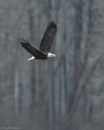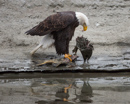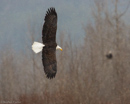Juneau, Haines, and the Chilkat Bald Eagle Preserve
page 3 of 5
Stephen Fischer Photography
Having a fast 500mm lens or greater at f/4 can really help to get high quality close-ups, although a telephoto with a shorter reach can also be acceptable. Many times these eagles will buzz in front of you too close to be composed with such a big lens. For this reason, I also carried a second body around my neck with a 100-400mm f/4.5-5.6 telephoto zoom lens attached for these types of opportunistic situations. As with most trips of this nature, I will travel with two bodies. In this case bringing a Canon 5D mark III with its full frame sensor, plus the newer cropped sensor Canon 70D body. In addition, I keep a 1.4x tele-converter in my pocket to be used depending on what type of reach that is needed. One must be careful about the tele-converter, as mentioned earlier it can sometime be too much lens for the situation, depending on how close you are, and how much light is available. In many cases the light was relatively low during the early morning or when the skies were overcast or it was snowing. In these lower light situations I will choose the 5Dmk3 with its superior high ISO performance, shooting up to ISO 6400, while trying to keep the shutter speed at a minimum of 1/800th of a second if possible. Under more ideal lighting conditions I may increase the shutter speed further to 1/1250th of a second and increase the focus range in sharpness by going with an aperture setting of up to f/8. This tends to be needed to get more of the eagle in focus given their long wingspan, or when trying to capture an action sequence involving multiple eagles.
Back on the low light performance, I will have to say that I have been impressed with the Canon 70D’s high ISO performance given it is a cropped sensor. Although not as good as the 5Dmk3, I would be comfortable shooting up to ISO 6400 in a pinch, and at IS0 1600 or below being preferred for higher quality results. On my previous 50D body, I would not bother shooting above ISO 800. So the 70D has been a big improvement in this regard. In some of the online photography forums such as DP Review, a few users have muttered about the auto-focus performance results of the 70D. But from my experiences so far, I have been satisfied with its behavior in this regard, and have the following suggestions for those not satisfied with their results with this body:
1. Keep the auto-focus in AI-servo mode as it will allow for a quicker focus response in comparison to the AI-focus mode. This should be a no-brainer for action photography and really independent of the Canon model. But I continue to be surprised by the number of users who have the camera in a different focus mode for this type of photography.
2. I programmed the focus mode to the single point spot focus, and set the focus priority for focus versus release for both the first and second images of AI servo mode. Once I have lock I prefer to keep it, as I find this to be more critical for birds-in-flight (BIF) versus the effort for acquiring the initial target.
3. Being used to the joystick focus select control of my 50D and 5Dmk3, I have not been a big fan of having to push the new focus mode button at the front of the camera by the shutter release to select a different focus sensor. This extra step tends to slow me down from what I have been used to with the joystick control of my other bodies. To remedy this, I programmed the multi-function wheel to act as the focus point selection control. This is little known option for the 70D camera under the custom controls documented in the larger online manual, but not found in the printed book that comes with the camera.
When initially planning for this trip, I budgeted five days in Haines and two days in the Juneau area for some additional side explorations. At first I was concerned if it would get too repetitious to spend this much time photographing eagles. But after the first couple of days I realized that the weather here is highly changeable, each day bringing different lighting conditions. The weather ranged between overcast, partly cloudy, snow, to full sun in as many days. In addition, some days the eagles would be more active than others, so between this and the highly changeable weather, any given day was not always dependable for higher quality photography of the eagles. But aggregating this over five days tended to be about right, allowing enough padding to ensure some good takeaways, while at the same time not getting too fatigued with over-tedious photography of the same subject. In comparison to previous photography of Sandhill Cranes at Bosque del Apache, a similar situation arose with the weather, but the birds tended to be more predictable, and thus a three day visit there seemed more adequate.
<article continued on the next page>











